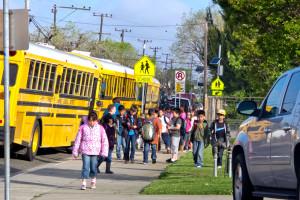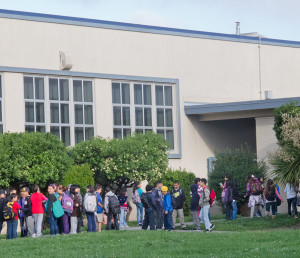
The San Leandro Unified School District was one of 11 statewide districts recently acknowledged as a model district by state superintendent Tom Torlakson for its longtime commitment to improving attendance and lowering the dropout rate.
Dedicated to relaying the importance of education to families and school children, San Leandro’s Student Attendance Review Board (SARB) began its unyielding campaign with the goal of seeing an overall upward turn in the district’s attendance rate.
“It’s important to support the notion that education is paramount,” said Sheila Lawrence, SARB chairperson. “You have to have education in order to succeed and go on to the next levels in life.”
The SARB process involves a collaboration of different community agencies that come together in efforts to solve a child’s truancy problems. At first offense, school sites send a series of letters to begin the communication process and alert the family of the dispute.
If the school site’s intervention is not successful, the SARB is notified, as the board is the last resort in the truancy process.
Lawrence said from that point on, the board is dedicated to getting to the core of the issue and improving the child’s future by stressing the significance of education.
The chairwoman, who joined the district four years ago, said she has seen a steady and stable increase in the attendance rate, which has ultimately had an effect on the school district’s dropout numbers.
“We’ve seen our dropout rate decrease as a matter of this constant campaign to push attendance,” said Lawrence. “It’s a very significant part of the whole process.”
The district wide attendance rate increased from 92 percent in 2008 to 96 percent in 2010, while the school system’s four year dropout rate remained at 18.7 percent in comparison to the near 83 percent graduation rate.
Torlakson publicly praised the local SARBS for their work in reducing student absence, which costs school districts millions of dollars each year in lost income, and greatly increases the chance of students dropping out of school.
“There’s a very basic fact that is often overlooked: Even the best teacher can’t help students who don’t make it to school,” Torlakson said in a recent press release distributed by the California Department of Education.
“These review boards are proving that there are highly effective strategies for improving attendance and reducing the dropout rate.”

Started in the late 1970s, the statewide review boards were mandatory in each school district, as they were once state funded. As the state made its way into the budget cut era, the SARB programs throughout California lost funding, forcing many districts to cease the truancy process.
“As a result, the attendance went down, because there were no teeth in it,” said Lawrence. Several parents began to think they did not have to enforce daily education because there were ultimately no consequences, she added.
Board member and clinical therapist Carol Righton says many parents are cavalier about the importance of attendance and don’t understand the real significance of arriving to school chronically late, which she says is why it’s important to catch the problem at an early age.
“[We try] to nip problems early on in their education, because if the kid misses too much school then they start off behind,” said Righton. Adolescents have not yet affiliated with gangs or began using illegal substances, so it’s not yet a chronic problem, she added.
“Recent studies have shown that chronic absenteeism that starts in kindergarten can cause students to have major reading problems by the third grade. Studies of the dropout rate also trace many of students’ academic struggles to early attendance problems,” according to the California Department of Education.
Righton, who has served on the board for nearly 10 years, has seen the program progress significantly since Lawrence implemented the strategic campaign designed to tackle the student absence problem.
“[Before], we seemed to have people that didn’t care much. It was something they just did because it was required,” said Righton. “When Sheila came on board, it was the first time I saw someone really take the job seriously.”
Lawrence said it was the continuous encouragement from her board members that pushed her to apply for the award.
“[The Award process] was pretty intense. You have to include all of the data supporting the significant gains that [the district] has had,” incorporated in a 10-page paper, said Lawrence.
Applications from local review boards statewide were evaluated by members of the California SARB in specific content areas ranging from program design and content to measuring and reporting outcomes, according to a recent press release from the California Department of Education.
Lawrence journeyed to Los Angeles to receive the award from Torlakson on the district’s behalf last week, guessing that the accomplishment would start to really sink in after the award was in her hands.
“For us, it’s knowing that we went into it with the right heart a few years ago and we’ve been really working to improve our program and to get this recognition,” said Lawrence. “It feels good.”











